W
WillCalderwood
We've got a 3 tile size opus pattern we're doing in travertine. The tiles have not been bought as a set, and therefore there's a slight spacing issue. The tile sizes are 610x610, 610x305 and 305x305. Now, they clearly fit together fine with no spacing (assuming they're all perfectly cut to size), but as you can see from the attached pattern below, if you take a line across it, some parts of the pattern have 3 spaces, others 2. We therefore have 2 options, the guy at Topps said use 4 & 3 mm spacers, I can't see for the life of me how that would work. Using 2 and 3 mm spacers we can ensure a total of 6mm of space across all areas of the pattern. So 3 2mm spacers where we have 3 spaces, and 2 3mm where we only have 2. Again attached example with massive spaces so they're easier to visualise. The 3rd option is obviously to trim 2mm off the smaller tiles where we have 3 spaces, ensuring we can use 2mm spacers throughout.
What would people recommend, visually and amount of work taken into account. Would mixed spacing look weird? Should we be trimming the tiles?
Thanks.

What would people recommend, visually and amount of work taken into account. Would mixed spacing look weird? Should we be trimming the tiles?
Thanks.
